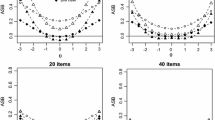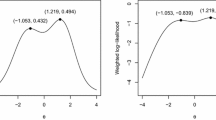Abstract
The case of adaptive testing under a multidimensional response model with large numbers of constraints on the content of the test is addressed. The items in the test are selected using a shadow test approach. The 0–1 linear programming model that assembles the shadow tests maximizes posterior expected Kullback-Leibler information in the test. The procedure is illustrated for five different cases of multidimensionality. These cases differ in (a) the numbers of ability dimensions that are intentional or should be considered as “nuisance dimensions” and (b) whether the test should or should not display a simple structure with respect to the intentional ability dimensions.
Similar content being viewed by others
References
Andersen, E.B. (1980).Discrete statistical models with social science applications. Amsterdam, The Netherlands: North-Holland.
Bloxom, B.M., & Vale, C.D. (1987, June).Multidimensional adaptive testing: A procedure for sequential estimation of the posterior centroid and dispersion of theta. Paper presented at annual meeting of the Psychometric Society, Montreal.
Chang, H-H., & Ying, Z. (1996). A global information approach to computerized adaptive testing.Applied Psychological Measurement, 20, 213–229.
Fraser, C., & McDonald, R.P. (1988).NOHARM II: A FORTRAN program for fitting unidimensional and multidimensional normal ogive models of latent trait theory. Armidale, Australia: University of New England, Centre for Behavioral Studies.
Glas, C.A.W. (1989).Contributions to estimating and testing Rasch models. Unpublished doctoral dissertation, University of Twente, The Netherlands.
ILOG. (2000).CPLEX 6.5 [Computer program and manual]. Incline Village, NV: Author.
Lehmann, E.L. (1999).Elements of large-sample theory. New York, NY: Springer-Verlag.
Lehmann, E.L., & Casella, G. (1998).Theory of point estimation. New York, NY: Springer-Verlag.
Lord, F.M. (1980).Application of item response theory to practical testing problems. Hillsdale, NJ: Lawrence Erlbaum Associates.
Lord, F.M., & Novick, M.R. (1968).Statistical theories of mental test scores. Reading, MA: Addison-Wesley.
Luecht, R.M. (1996). Multidimensional computerized adaptive testing in a certification or licensure context.Applied Psychological Measurement, 20, 389–404.
Reckase, M.D. (1985). The difficulty of test items that measure more than one dimension.Applied Psychological Measurement, 9, 401–412.
Reckase, M.D. (1997). A linear logistic multidimensional model for dichotomous item response data. In W.J. van der Linden & R.K. Hambleton (Eds.),Handbook of modern item response theory (pp. 271–286). New York, NY: Springer-Verlag.
Segall, D.O. (1996). Multidimensional adaptive testing.Psychometrika, 61, 331–354.
Segall, D.O. (2000). Principles of multidimensional adaptive testing. In W.J. van der Linden & C.A.W. Glas (Eds.),Computerized adaptive testing: Theory and practice (pp. 53–73). Boston, MA: Kluwer Academic Publishers.
Swanson, L., & Stocking, M.L. (1993). A model and heuristic for solving very large item selection problems.Applied Psychological Measurement, 17, 151–166.
van der Linden, W.J. (1996). Assembling tests for the measurement of multiple traits.Applied Psychological Measurement, 20, 373–388.
van der Linden, W.J. (1999). Multidimensional adaptive testing with a minimum error-variance criterion.Journal of Educational and Behavioral Statistics, 24, 398–412.
van der Linden, W.J. (2000). Constrained adaptive testing with shadow tests. In W.J. van der Linden & C. A. W. Glas (Eds.),Computerized adaptive testing: Theory and practice (pp. 27–52). Boston, MA: Kluwer Academic Publishers.
van der Linden, W.J., & Pashley, P.J (2000). Item selection and ability estimation in adaptive testing with shadow tests. In W.J. van der Linden & C.A.W. Glas (Eds.),Computerized adaptive testing: Theory and practice (pp. 1–25). Boston, MA: Kluwer Academic Publishers.
van der Linden, W.J., & Reese, L.M. (1998). A model for optimal constrained adaptive testing.Applied Psychological Measurement, 22, 259–270.
Veldkamp, B.P. (2002).Modifications of the branch-and-bound algorithm for use in constrained adaptive testing. Manuscript submitted for publication.
Author information
Authors and Affiliations
Rights and permissions
About this article
Cite this article
Veldkamp, B.P., van der Linden, W.J. Multidimensional adaptive testing with constraints on test content. Psychometrika 67, 575–588 (2002). https://doi.org/10.1007/BF02295132
Received:
Revised:
Issue Date:
DOI: https://doi.org/10.1007/BF02295132




